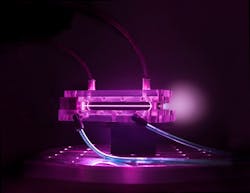Compact free-electron lasers to be developed at LBNL
Lawrence Berkeley National Laboratory (LBNL) researchers will receive $2.4 million from the Gordon and Betty Moore Foundation to develop compact free-electron lasers. The technology could lead to portable and high-contrast X-ray imaging to observe chemical reactions, visualize the flow of electrons, or watch biological processes.
A free-electron laser uses an accelerator to produce a high-energy electron beam that produces laser radiation. Laser-plasma accelerators, however, are an emerging technology. Research to-date has produced electron beams with sufficient energy to produce laser radiation, but other measures related to the quality of these beams still remain unresolved.
Related: Free electron lasers thrive from synergy with ultrafast laser systems
“We are now in the position that we know enough that we want to push for this next big challenge: can we build small accelerators and produce radiation that is typically produced by larger accelerators?” said Wim Leemans, director of the Accelerator Technology and Applied Physics Division (ATAP) at Berkeley Lab. “We want to develop these accelerators in such a way that accessing the light produced by these beams is much less expensive and can be performed in much smaller settings.”
The Moore Foundation grant will enable experiments that address this question by observing free-electron lasers operating at short wavelengths using an electron beam from a laser-plasma accelerator. Leemans, who also directs the Berkeley Lab Laser Accelerator (BELLA) center housing one of the most powerful lasers in the world, will work with a team that also includes Berkeley Lab senior scientist Carl Schroeder and scientist Jeroen van Tilborg, along with postdoctoral researchers, graduate students, and technical staff.
